Content
- 1 General description and application
- 2 Classification of varieties
- 3 The best daikon varieties by soil classification
- 4 Groups of daikon varieties by climatypes (seasonal dependence)
- 5 The best varieties of domestic breeders in terms of ripening
- 6 Video tips for growing daikon
- 7 Daikon varieties
- 8 How to grow daikon radish outdoors: planting and care
- 9 The best daikon varieties for the middle lane (with photo)
- 10 The healing properties of daikon
This subspecies of radish is as frequent a guest on the Japanese table as potatoes in Russian. But, if radish in Russia has been eaten from time immemorial, then the daikon came to us from the east relatively recently. At the same time, he very quickly got used to it and has now surpassed his predecessor in popularity. And this is understandable. Unpretentious care, lack of bitter pungency and unpleasant pungent odor, so familiar to radish lovers, juiciness and noble appearance - all this disposes to make a choice in favor of a guest from the east.
General description and application
Outwardly, the vegetable usually looks like a large white carrot. However, the shape of the root crop varies by variety and can vary greatly, from nearly round to serpentine or spindle-like. Their length may not exceed a long-fruited radish, and may reach up to 2 meters. This is an annual, but it gives ripe seeds only for the second year. To choose the best variety of "Japanese radish" for planting on your site, first of all, you need to understand the mutual requirements: what we want from him and what he will demand from us.

Ripening, depending on the species, lasts from 2 to 6 months. The yield reaches 10 kg from a garden bed of 1 sq. m (more often - 4-8 kg). Some species can be stored without loss of quality for up to six months, the average storage time is 2-3 months. It is eaten raw, salted, boiled, young leaves and cuttings go well for salad.
The daikon has a negative character trait - he loves to shoot. The extended arrow has a negative effect on the quality of the root, although not to the same extent as in radish. But long daylight hours are contraindicated for him. It is better to plant it either in early spring or in mid-late summer, depending on the climate of the region. In the middle lane, the best time is July, in the more southern regions - August. During these periods, it gives the most significant yield.
Classification of varieties

There are several types of classification of this culture:
- Depending on the depth of the roots in the ground. Some are almost completely immersed in it, while others are half, a third, or even a quarter.
- By the duration of the growing season and, accordingly, the timing of harvesting.
- Depending on the characteristics of the soil. It should be noted that in relation to the soil, this root crop is an ascetic. Some groups can even be grown on clay.
- By the shape of the roots and their size.
Digging the beds for "tall" varieties is often difficult because of their great depth. But solid ground stops the growth of root crops, therefore, on clay, loamy and other loose soils, experienced gardeners sometimes use a drill for planting.
The best daikon varieties by soil classification
Minovase - This is a large group of early high-yielding species that produce roots with snow-white, juicy, weakly pungent pulp. The shape is elongated-cylindrical, in the middle lane it grows up to half a meter long. High degree of crop safety. Deepening - up to 3/4 of the length. It tolerates drought and hot summer well, ripens in 60 days.
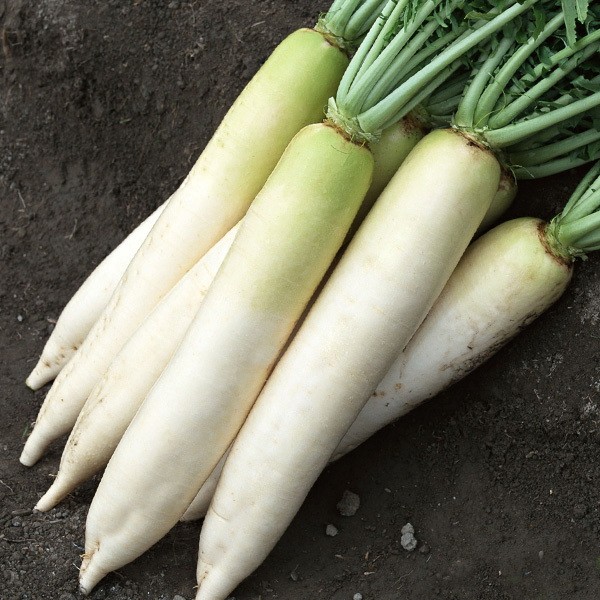
Ninengo - cylindrical or cone-shaped elongated fruits are completely submerged in the ground. Loves light soils, but is not capricious in this regard, resistant to cold snaps, grows up to 60 cm in 70-75 growing days.
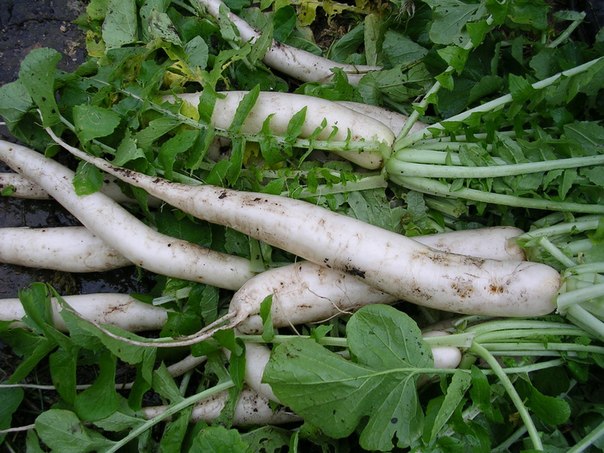
Elephant fang - the most widespread selection hybrid of the Chinese model with the Tashanhong radish in Russia. The elongated cylindrical white root vegetable has a light green pigmentation, grows up to 18-22 cm. It is 2/3 of its length above the surface. Has a juicy, sweet-spicy taste. Adapted for summer-autumn ripening, during this period it is resistant to flowering. When grown in northern latitudes (above 55 ° N), it is not suitable for spring sowing, because begins to shoot arrows and bloom, bypassing the fruiting phase.

Nerima - bears fruit readily and well on loose, light soils. Ripens for a relatively long time, 70-100 calendar days. Root crops are smooth greenish, up to 60-70 cm in length, 2/3 submerged in the ground.
They are good fresh and salted.

Miyashige - unpretentious to the soil, but shows the best yield on loam. Root crops of medium length, cylindrical shape, light green color. Ripens in 60-80 days. It can be used in any form, it is well suited for salting, but the piquant taste of dishes with the addition of boiled Miyashige is especially worth noting.

Shiroagari - varieties specially bred for cultivation in heavy soils. Small in length, up to 30 cm, this root is immersed in them only by a third or even a quarter, which allows you to get a good harvest on a poor fertile layer.
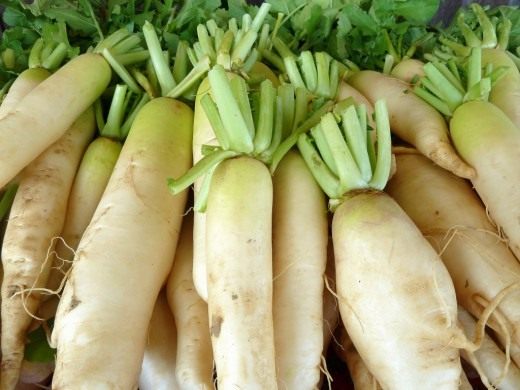
Shogoin - another small group for cultivation on heavy soils. It is preferable to eat fresh, salads. The vegetative period is 70-100 days.
Kameido - loves sandstones and light soil compounds. It goes deep into 2/3. Small in size, only up to 15 cm in length and 5 cm in diameter, conical in shape, with a slight pleasant sharpness. They are distinguished by particularly juicy cuttings and foliage, which are good for seasonal salads.
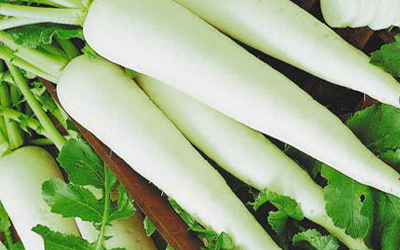
Groups of daikon varieties by climatypes (seasonal dependence)
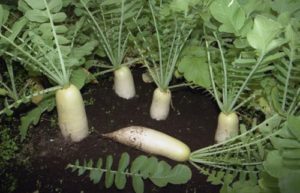 Haru (spring) - all varieties of this group have increased resistance to stalking and are suitable for year-round cultivation (in the presence of appropriate climatic conditions), including for early spring sowing. Therefore, they are of particular interest to gardeners of middle latitudes. Planted in early spring, they make it possible to harvest in late May or early June. After that, you can repeat the planting and harvest another crop in August-September. In regions with a warm climate, a third sowing in winter is possible.
Haru (spring) - all varieties of this group have increased resistance to stalking and are suitable for year-round cultivation (in the presence of appropriate climatic conditions), including for early spring sowing. Therefore, they are of particular interest to gardeners of middle latitudes. Planted in early spring, they make it possible to harvest in late May or early June. After that, you can repeat the planting and harvest another crop in August-September. In regions with a warm climate, a third sowing in winter is possible.
Hatsu (summer) - early ripening. You can dig up root crops after 50-55 days. It is sown in the "daikon off-season", in late spring or early summer. It is a salad-type vegetable that is resistant to hot weather.
Aki (autumn) - sowing of vegetables of this group is carried out in mid-late August (late and mid-late varieties). These include such well-known varieties as Shiroagari, Shigoin, Nerima, Miyasinge. They differ from their summer counterparts in yield and impressive sizes.
Fuyu (winter) - a very small group and little demanded in the conditions of the Russian climate, suitable for cultivation only in the southern warm regions, where frosts are excluded.
Daikon loves empty lands and is ideal for sowing after harvesting early crops - onions, radishes, lettuce, various greens.
The best varieties of domestic breeders in terms of ripening
Early ripening
A group of early-maturing vegetables with a growing season of 40 to 50 days.
- Sasha - cold-resistant variety with a fruit root length of 6-12 cm and its weight up to 400g. A delicate white pulp with excellent taste ripens under the thin skin.
- Prince of danish - fruits of red "radish" color, juicy and very delicate in taste.
- Snow White - has good storage stability (up to 5 months). Under the light green skin, there is a snow-white flesh with a thin speck.

Mid-season
Ripening in 60-80 days.
- The Dragon - a cylindrical vegetable growing to a mass of 1 kg and up to 60 cm long. The taste is slightly sweet, pleasant, goes well with other ingredients.
- Dubinushka - slightly shorter than the previous grade, but gaining weight up to 1.2 kg.Has a fresh, pleasant taste without pungency.
- The emperor - resistant to cruciferous flea beetles, many diseases and flowers. Outwardly, it resembles an ice icicle. The pulp is soft, with a sweetish aftertaste.

Late ripening
Slow ripening vegetables, "phlegmatic". Late ripening after 90-200 days complicates their cultivation in the middle lane. But these root crops are record holders in size.
- Japanese long - practically does not shoot arrows, gives a very high yield, the weight of one root can reach 3 kg. The taste is moderately spicy, it can be stored for a long time.
 A well-chosen daikon variety is already half the success. It is unpretentious to care for if the growing conditions correspond to the selected species. "Japanese radish" is good for health, it is one of the few vegetable crops that help restore the liver and dissolve kidney stones. It is recommended to eat it for the elderly. Suffice it to recall that the Japanese allot one tenth of their precious land for sowing the daikon. And the Japanese don't just do anything!
A well-chosen daikon variety is already half the success. It is unpretentious to care for if the growing conditions correspond to the selected species. "Japanese radish" is good for health, it is one of the few vegetable crops that help restore the liver and dissolve kidney stones. It is recommended to eat it for the elderly. Suffice it to recall that the Japanese allot one tenth of their precious land for sowing the daikon. And the Japanese don't just do anything!
Video tips for growing daikon
Daikon (japanese radish) Is a vegetable culture that has recently been gaining popularity among summer residents.
The plant is a subspecies of sowing radish, although, unlike the latter, daikon roots do not contain mustard oils and have a moderate aroma.
There are many varieties of Japanese radish, but in Russia the most famous are:
«Snow White», «Sasha», «Caesar», «Flamingo», «The Dragon», «Big bull», «Elephant fang», «Dubinushka», «Japanese white long».
Daikon varieties
Snow White - early ripening variety. Produces a good harvest both outdoors and in greenhouses. Root crops are white cylindrical in shape, the flesh is slightly sharp, juicy. Stored up to months. Productivity from 5 to 8 kg / m2.
Big bull - refers to mid-season varieties of Japanese radish. Root crops are large, cylindrical, juicy. Root weight up to 3 kg. Keeping quality good, stored until spring.
The Dragon - mid-season variety. Root crops are cylindrical with a conical transition, smooth. Weight up to 1 kg... The pulp is juicy, tender, white. The taste is sweetish.
Suitable for growing outdoors in summer cottages. The variety is suitable for long-term storage and fresh consumption. The yield is high.
Dubinushka - mid-season daikon variety. Root crops are cylindrical, white, dense, tasty. "Dubinushka" is ideal for growing in protected and open ground in garden plots. Keeping quality is high up to months. Yield up to 10kg / m2... Root crops weighing up to 1.5KG.
Elephant fang - mid-season variety. Cylindrical root crop, white, up to 60 cm... The yield is high, the mass of root crops is up to 0.5KG... The pulp is juicy, white. Suitable for long-term storage and fresh consumption.
Sasha - early ripening variety of Japanese radish, cold-resistant. Root crops are short, cylindrical, smooth, white. The pulp is tender, tasty, juicy. Weight up to 450 g... Resistant to diseases and premature stems. Average yield up to 5kg / m2... Used in any form. The growing season is up to days.
Caesar - mid-season variety. Cylindrical root crops long up to 40 cm... The pulp is white, juicy, reminiscent of the taste of a radish. Recommended for outdoor cultivation. It is consumed fresh, not suitable for long-term storage.
Flamingo - hybrid mid-season variety. Root crops are icicle-shaped even. The pulp is pink, juicy, tasty. Recommended for growing in garden plots for fresh consumption. Yield up to 6 kg / m2, mass up to 1 kg... The variety is resistant to flowering.
Japanese white long - late-ripening variety. Root crops are white, long, weighing up to 3 kg... The pulp is juicy, white, slightly spicy. Differs in good keeping quality and high yield. It won't flab for a long time.
Video - Variety "Dragon"
Share with your friends on social networks
How to grow daikon radish outdoors: planting and care
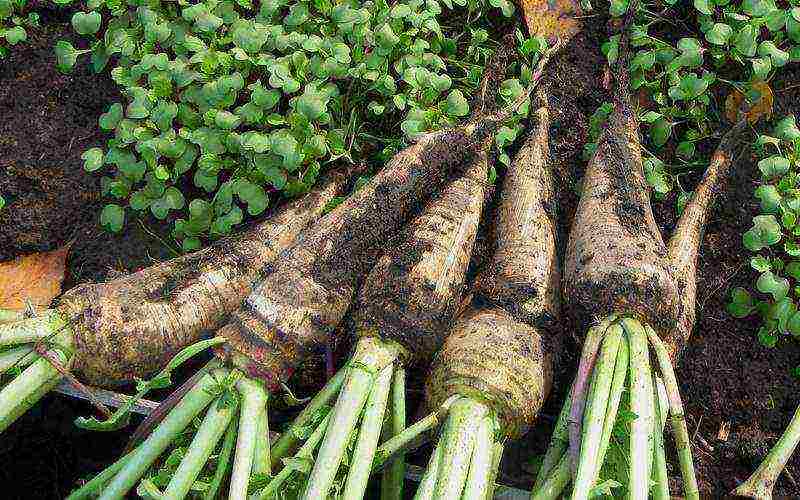
Radish daikon in the photo
Daikon is a promising new vegetable crop. His homeland is Japan.This is not a radish or a radish, although it is closely related, but still a special culture.
Daikon, unlike its relatives, has completely different taste qualities. There is no pungency and bitterness in it, the specific smell inherent in radish. Daikon fruits are more juicy and tender. This crop gives a high yield of root crops - up to 10 kg per 1 m2 - and has a good keeping quality (2-3 months without significant losses in quality).
Care when growing daikon in the open field is not difficult, because it is a rather unpretentious plant, it can be cultivated even on heavy clay soils. However, high yields of better quality root crops are obtained on light, fertile soils. The same soils are most suitable from the point of view of harvesting, especially for varieties with a root crop deeply embedded in the soil. Before planting a daikon in open ground, the soil for this culture should be well filled with organic fertilizers - compost and humus.
Growing and caring for daikon radish is done in the same way as for turnips. Seeds are sown to a depth of 3-5 cm in two rows on beds with a distance between rows of 60-70 cm, and between plants in a row - 20-25 cm. Seedlings will appear on the 5-7th day.
In the future, leaving is reduced to weeding, loosening and watering, protection from cruciferous fleas.
Top dressing when growing daikon in the open field on well-fertilized soils is not done; if necessary, it is timed to the phase of 1-2 true leaves (after thinning).
Daikon loves fertile and deeply cultivated soil, because in a short time (40-65 days) it increases the mass of the root crop up to 3 kg, sometimes up to 50 cm long.
The last summer date for planting daikon radish is early August. True, in this case, the root crops do not have time to reach a significant size, which reduces the yield.
The crop is harvested after 40-70 days, depending on the variety, the harvest is carried out in dry weather. On light soils, the roots are pulled out by the tops, and on heavy soils, they are undermined with a shovel so as not to break the long juicy roots. Store the vegetable in plastic bags or sandwiched in boxes. The daikon is well preserved in the basement and in the refrigerator at temperatures from 0 to + 5 ° C.
The best daikon varieties for the middle lane (with photo)
Our most popular varieties are summer sowing (from mid to late July), although there is a Sasha variety that yields a harvest even when sown in spring.
The best daikon varieties for summer sowing are:
"Minovase" - super-yielding, mid-season variety, from germination to technical ripeness - 50-60 days. Root crops are white, cylindrical, up to 45 cm long, 3/4 buried in the soil. The pulp is juicy and crispy. Used fresh.
Miyashige - This variety has a smooth, thin skin. Root weight 100-140 g. Resistant to flowering, cold-resistant.
"Pink Shine Misato" - a variety with lined, round, white roots with a diameter of 10 cm. Delicate, juicy, bright pink pulp is a decoration for any table.
"Red Samurai" F1 - a new unique early ripe hybrid that gives an excellent yield of cylindrical root crops 15-35 cm long and 7-8 cm in diameter, weighing up to 5 kg. The juicy and tender pulp of these root vegetables is much more tender than that of many radishes. Unlike radish, daikon roots, even flowering ones with an arrow, remain juicy and retain a good taste: there is no significant lignification of tissues.
"Dubinushka" - mid-season variety, from germination to harvesting of root crops - 56-63 days. Root crops are white, with a yellowish-green head, cylindrical, up to 40 cm long, weighing 0.7-1.5 kg. This daikon variety, popular in the middle lane, has a white, juicy flesh. Root vegetables are well kept.
"The Dragon" - a mid-ripening variety (from germination to technical maturity 65-70 days) for growing in open and protected ground. The root crop is smooth, white, cylindrical with a conical escape, weighing 0.9-1.0 kg, 30-60 cm long, immersed in the soil by 1 / 3-1 / 2 of the length. The pulp is very juicy, tender, white, sweetish refreshing taste.
"Snow White" - early ripening variety for spring greenhouses and open ground (spring and summer-autumn culture). Resistant to flowers.
"Russian size" F1 - the earliest and largest-fruited daikon hybrid for summer sowing in temperate climates. After planting, with proper care, the daikon of this variety is ready for harvesting already 45 days after germination. Reaches 60 cm in length and 12 cm in diameter. Root crops are cylindrical, slightly running down to the tip, with a white smooth surface.
As you can see in the photo, this daikon variety has cylindrical and blunt-conical roots, white, with a light green head:
The pulp is juicy, with a mild taste. Productivity 5-8 kg / m2. In winter, it is stored in the sand for 4-5 months.
The healing properties of daikon
Unlike radishes, daikon root vegetables can be eaten not only fresh, but also boiled and salted.
Daikon helps to eliminate cholesterol from the body. The bactericidal properties of daikon are also known.
Young daikon leaves are also used for food, in which the content of vitamin C is even higher than in root crops, and amounts to 44 mg per 100 g of leaf mass. In addition, they contain beta-carotene, vitamins B1, B2, PP, E. Daikon is consumed for colds, to normalize intestinal activity, to strengthen hair. Root vegetables are used in many cuisines of the peoples of the world: in Japanese, and in Chinese, and in Vietnamese, and in Tibetan.
Knowing how to grow a daikon, you can provide your family with an environmentally friendly harvest. The selective ability of this crop to remove nutrients from the soil is truly unique. Root crops do not accumulate heavy metals (zinc, lead), radionucleides. Daikon, like radishes and radishes, contains a lot of potassium salts, which remove excess water from the body, and calcium, fiber, pectin substances, vitamin C and enzymes that promote digestion. It also has healing properties due to the content of glycosides, phytoncides and specific protein substances that inhibit the growth of bacteria. Root crops of this culture contain active enzymes that aid in the digestion of starchy foods.
Of all the vegetable plants, only radish, daikon and horseradish are able to cleanse the liver and kidneys, including dissolving stones. However, radish and horseradish contain too many rare (mustard) oils, which give the taste of these vegetables pungency, bitterness and stimulating the heart. Daikon is another matter. It does not have a dramatic side effect, since it practically does not contain those oils.
Rate the article:
(0 votes, average: 0 out of 5)
Daikon - vegetable, which is one of the subspecies of sowing radish, belonging to the Cabbage family. This one- or two-year garden culture, in our country referred to as "white radish", "sweet radish" or "Japanese radish", was first bred by Japanese breeders. In its homeland, daikon occupies a dominant place among other vegetable plants.
And on the territory of our country, the popularity of this root crop has grown significantly in recent years. No wonder - it is very tasty, can be stored for a long time and is easy to grow. To the taste of the pulp, it is somewhat reminiscent of the radish familiar to many. Daikon is characterized by excellent nutritional qualities and its invaluable medicinal properties.
What does a daikon look like? Its shape can be completely different (it all depends on the variety) - round, serpentine, conical, cylindrical. The length of daikon radish ranges from 10 to 60 cm. The average weight of one root crop is 0.5-3 kg. But there are also real "giants" weighing 5 kg. When ripe, the daikon is either completely buried in the ground, or protrudes above the ground by a third (less often - by 2/3).
There are a great many varieties of daikon. Each of them differs in terms of planting and ripening, growing conditions, shape and taste of the fruit.When choosing a variety, focus on the conditions in which it will grow, the required shelf life and disease resistance.
Let's list the best daikon varieties that can be cultivated in Russia.
| Minovase. This is a fairly popular variety of Japanese daikon among domestic summer residents, due to its rapid maturation, heat resistance and resistance to diseases. Root crop - elongated, cylindrical, 40-50 cm long, 7-9 cm in diameter, white. When ripe, 3/4 of its length is hidden in the soil. |
|
| Sasha. This variety of white daikon is cold-resistant, ripens early (about 40 days after planting), highly productive, resistant to diseases and early flowering. Root crop - in the form of a cylinder, half hidden in the ground when ripe, with tender pulp, weighing up to 0.4 kg. |
|
| Pink glitter. It is a beautiful variety with a juicy, pale pink pulp. Daikon Pink sheen is only suitable for sowing in the autumn. The root crop is round in shape, leveled, up to 10 cm in diameter. |
|
| Elephant fang. This variety belongs to the mid-season - maturity occurs no later than 80 days after planting. Root crop - up to 60 cm long, weighing up to 0.5 kg, white, with very juicy pulp. |
|
 |
Dubinushka. This variety belongs to the mid-season - you can harvest the crop after 60 days after planting. Daikon Dubinushka is famous for its keeping quality (up to 6 months) and is cultivated mainly for autumn-winter consumption. The root crop is a thickened-cylindrical shape with a pointed base, white with a greenish-yellow head and shoulders, weighing up to 2 kg, up to 60 cm long. |
| Caesar. The daikon can be harvested from the site 70 days after planting. This variety is famous among summer residents for its pleasant radish taste. The root crop is in the form of a cylinder, white, up to 40 cm long. Daikon Caesar is recommended to be planted in a high bed, since at the time of ripening it is deeply immersed in the ground. |
|
| Snow White. This variety is popular because of its resistance to flowering, long shelf life (up to 5 months) and early maturity. The root vegetable is cylindrical or conical in shape, slightly spicy in taste, white with a pale green head. |
|
| Big bull. This daikon can be classified as a mid-season variety that can be stored all winter. The root crop is very juicy, weighing up to 3 kg, in the form of a cylinder. |
|
| The Dragon. The variety belongs to the mid-season (ripens 70 days after planting in the ground), is stored for a long time, is characterized by excellent culinary and dietary qualities. On the territory of our country, the Daikon Dragon is planted in open ground by the end of July. The root crop is in the form of a cylinder, up to 60 cm in length, up to 8 cm in diameter, smooth, white, sweetish in taste. |
|
| The emperor. This is a mid-season hybrid of Japanese radish. The root crop is red, in the form of a cone with a flat head, with a rather dense pulp, weighing up to 0.6 kg. When ripe, the vegetable is immersed in the ground by 2/3. |
|
| Favorite. It is a mid-season variety characterized by excellent culinary qualities and resistance to early shooting. Root crop - in the form of a cone, white with a greenish head, weighing up to 0.5 kg. |
|
| Tokinashi. This high-yielding variety is classified as early ripening. The root vegetable is cone-shaped, of good taste, up to 60 cm long. This daikon eats not only fruits, but also leaves with petioles. |
|
| Miyashige. The variety is mainly intended for sowing in the spring, resistant to shooting, perfectly tolerates cold. The root crop is smooth, white, weighing up to 0.4 kg, with a thin skin. |
|
| Tsukushi spring cross. An early ripe variety used for sowing in the spring, resistant to shooting, has a long shelf life. Root crop - in the form of a cylinder, white with pale green shoulders, weighing up to 0.8 kg, smooth. |
|
| Shogoin. This variety of Japanese radish is famous for its high yield. The root crop is round, weighing up to 2.5 kg, very juicy in taste. |
|
| Japanese white long. This high-yielding variety, resistant to flowering and flabbiness, belongs to the late-ripening varieties. Root vegetable - slightly spicy in taste, up to 65 cm long, up to 3 kg by weight. |


